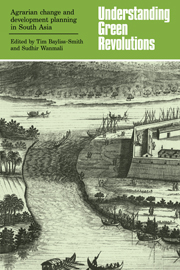Book contents
- Frontmatter
- Contents
- List of contributors
- Preface
- I Understanding Green Revolutions: an overview
- II Agrarian change at village level
- III Development planning and agrarian change
- 12 Rural-based models for rural development: the Indian experience
- 13 Planning and agrarian change in East Africa: appropriate and inappropriate models for land settlement schemes
- 14 Metropolitan expansion in India: spatial dynamics and rural transformation
- 15 Green Revolution and water demand: irrigation and ground water in Sri Lanka and Tamil Nadu
- 16 Social organisation and irrigation: ideology, planning and practice in Sri Lanka's settlement schemes
- 17 Environmental hazard and coastal reclamation: problems and prospects in Bangladesh
- 18 Beyond the Green Revolution: a selective essay
- Index
13 - Planning and agrarian change in East Africa: appropriate and inappropriate models for land settlement schemes
Published online by Cambridge University Press: 25 May 2010
- Frontmatter
- Contents
- List of contributors
- Preface
- I Understanding Green Revolutions: an overview
- II Agrarian change at village level
- III Development planning and agrarian change
- 12 Rural-based models for rural development: the Indian experience
- 13 Planning and agrarian change in East Africa: appropriate and inappropriate models for land settlement schemes
- 14 Metropolitan expansion in India: spatial dynamics and rural transformation
- 15 Green Revolution and water demand: irrigation and ground water in Sri Lanka and Tamil Nadu
- 16 Social organisation and irrigation: ideology, planning and practice in Sri Lanka's settlement schemes
- 17 Environmental hazard and coastal reclamation: problems and prospects in Bangladesh
- 18 Beyond the Green Revolution: a selective essay
- Index
Summary
Land settlement schemes have been defined by B.H. Farmer as ‘the establishment of people on wasteland by government organisations for agricultural purposes and in groups large enough to require completely new villages’ (Farmer, 1974, p. 1). In South Asia schemes of this sort are often termed ‘agricultural colonisation’. They appear to provide particularly favourable conditions for the introduction of new technology such as that associated with the Green Revolution, for innovations in the provision of social services, and for land tenure reform.
Unfortunately, experience in a range of countries has shown that land settlement does not necessarily provide any simple answer to problems of development planning. The design of land settlement schemes and land tenure policies is still not an exact science, and although research in this area has expanded, our capacity to design successfully is not noticeably more advanced today than when B.H. Farmer (1957) conducted his pioneer study of Pioneer Peasant Colonization in Ceylon thirty years ago. The model which I am proposing in this chapter aims to provide a context in which planning interventions in this area can be viewed. My intention is to appraise alternative policy options for problems of land and population in land-surplus rural sectors. Such conditions are typical of large areas of tropical Africa and south-east Asia, and are not altogether absent even in more densely populated regions. The discussion is illustrated with examples drawn mainly from East African experience.
- Type
- Chapter
- Information
- Understanding Green RevolutionsAgrarian Change and Development Planning in South Asia, pp. 270 - 279Publisher: Cambridge University PressPrint publication year: 1984
- 1
- Cited by



